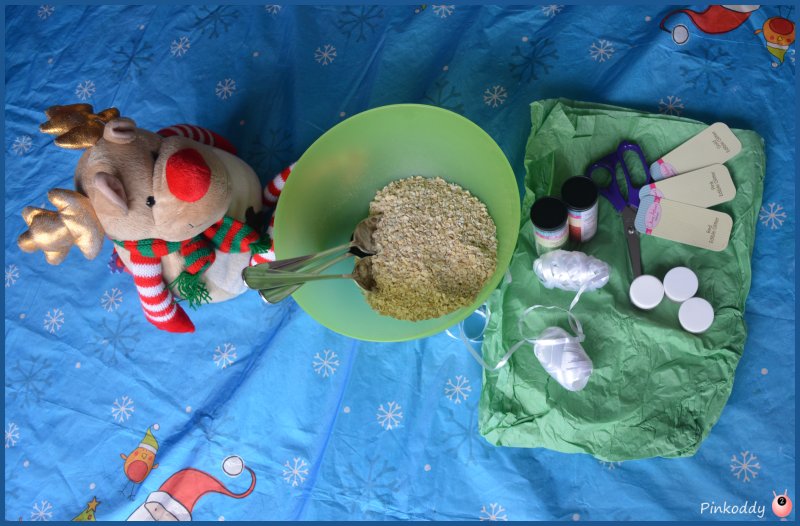
Reindeer Food and Other Sensory Christmas Ideas
To help The Sensory Seeker cope with Christmas we put a few things in place and one of the things we do is plenty of Sensory fulfilling ideas such as Christmas Crafts. This year we decided to make Reindeer food. This just comprises of oats for the Reindeer to eat and edible glitter so that it shines and they can see where it is/which house to go to.
 I got the idea from Mum in the Madhouse – also told me that I can purchase the glitter for £1 from Poundland. I really simplified the idea down so that it was easy for The Sensory Seeker to understand and did not demand too much from him. We used some tissue paper to make a bag with which we tied with a bit of ribbon that we had been using to decorate our presents.
I got the idea from Mum in the Madhouse – also told me that I can purchase the glitter for £1 from Poundland. I really simplified the idea down so that it was easy for The Sensory Seeker to understand and did not demand too much from him. We used some tissue paper to make a bag with which we tied with a bit of ribbon that we had been using to decorate our presents.
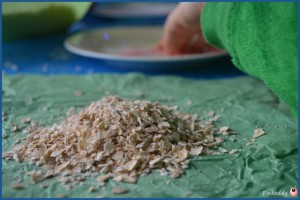 I put a big bowl of porridge oats in the middle of the table with some spoons. The idea is to put a mix of oats and different colour glitters into the center of the tissue paper. This was good for helping him with his fine motor skills (holding the spoon), hand-eye co-ordination (moving from bowl to paper), and thinking about how much oats were on the paper (he did struggle with this last bit as he kept on going). Of course, like any activity, it also helped him increase his concentration and attention span too.
I put a big bowl of porridge oats in the middle of the table with some spoons. The idea is to put a mix of oats and different colour glitters into the center of the tissue paper. This was good for helping him with his fine motor skills (holding the spoon), hand-eye co-ordination (moving from bowl to paper), and thinking about how much oats were on the paper (he did struggle with this last bit as he kept on going). Of course, like any activity, it also helped him increase his concentration and attention span too.
 The same skills were also applicable to the glitter. Doing an activity of this kind really helps to calm and focus The Sensory Seeker who really struggles in these last days of the excitement to Christmas. He does not quite understand time either so is always so hyped up that Christmas will be here soon. It is good to get him to sit still for a little while.
The same skills were also applicable to the glitter. Doing an activity of this kind really helps to calm and focus The Sensory Seeker who really struggles in these last days of the excitement to Christmas. He does not quite understand time either so is always so hyped up that Christmas will be here soon. It is good to get him to sit still for a little while.
The Sensory Seeker will then put out the Reindeer Food on Christmas Eve before bed. Doing this as a tradition every year will mean that over time he will begin to understand that it is the night before Christmas.

Check out these other Sensory Christmas ideas from other bloggers:
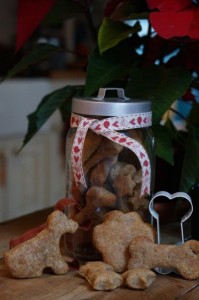 Over on ParentShaped there’s some home made dog treats – like play dough that dogs can eat. Perfect for those with Sensory needs with a dog.
Over on ParentShaped there’s some home made dog treats – like play dough that dogs can eat. Perfect for those with Sensory needs with a dog.
 Another Play Dough inspired idea is this Ginger Bread Latte Play Dough and Chocolate Play Dough by Crafts on Sea, and over on the Gingerbread House they have Gingerbread playdough (or as an alternative to playdough there’s Gingerbread Cloud dough). They are really good for the tactile and olfactory senses. Although you do have to be careful with Sensory Seekers as the recipe has a lot of salt in it so not good for those who always put things in their mouth. Whilst In The Playroom has Sparkly Gel Dough. Whilst all the play dough recipes are good for tactile and hand
Another Play Dough inspired idea is this Ginger Bread Latte Play Dough and Chocolate Play Dough by Crafts on Sea, and over on the Gingerbread House they have Gingerbread playdough (or as an alternative to playdough there’s Gingerbread Cloud dough). They are really good for the tactile and olfactory senses. Although you do have to be careful with Sensory Seekers as the recipe has a lot of salt in it so not good for those who always put things in their mouth. Whilst In The Playroom has Sparkly Gel Dough. Whilst all the play dough recipes are good for tactile and hand
development, this sparkly dough has an added visual stimulation: Good for those Seeker or needing stimulation.
 We are also working on a range of Christmas Tree crafts and I do love the Pipe Cleaner Christmas Trees on Zing Zing Tree, just perfect for fine motor development and helping with the tactile element as the pipe cleaners and pompoms have different textures.
We are also working on a range of Christmas Tree crafts and I do love the Pipe Cleaner Christmas Trees on Zing Zing Tree, just perfect for fine motor development and helping with the tactile element as the pipe cleaners and pompoms have different textures.
- Egg Carton Christmas Tree
- Christmas Tree Hand made Biscuit Gifts
- Apple & Cinnamon Ornaments
- Tactile Christmas Tree
- Sensory Christmas Tree
- Hot Chocolate Santas – Teacher Gifts
- Glitter Sticks
- Candy Cane
- Candy Cane Rice
- Apple Jack Wreaths
- Christmas Tree Brownies
Also see:
- Christmas Special Needs – Adapting life to make things easier
- Visiting family and friends at Christmas with Sensory Processing Disorder
- Our Little Angel – The Christmas Production
- Christmas Cards and The Sensory Seeker
- Christmas Crafts for The Sensory Seeker
- I’m just a sheep!
- Bad Days
I am going to find as many Sensory Craft ideas as I can -such as this Writing Practice Sensory Bag on In the Playroom. If you have a Sensory Activity then I would love to know about it please. Could you kindly comment below, catch me on Social media or e-mail me. Thank you.
I hope you have a very Merry Christmas.













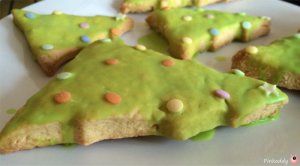




 I love this little craft as it is so simple but so personal. Simply cut out the shape of the head and paint brown, whist also making 2 hand prints. Once dry glue together and add a tissue paper red nose, and two black eyes. Thread it up with a “Stop here Santa” sign and one at the back to hang up.
I love this little craft as it is so simple but so personal. Simply cut out the shape of the head and paint brown, whist also making 2 hand prints. Once dry glue together and add a tissue paper red nose, and two black eyes. Thread it up with a “Stop here Santa” sign and one at the back to hang up. Or what about letting them lose with
Or what about letting them lose with  Or if your child has some patience then why not make a Reindeer from a toilet roll holder. We painted him brown and let him it dry, before simply adding the eyes, pompom nose and feather ears. This was part of our
Or if your child has some patience then why not make a Reindeer from a toilet roll holder. We painted him brown and let him it dry, before simply adding the eyes, pompom nose and feather ears. This was part of our 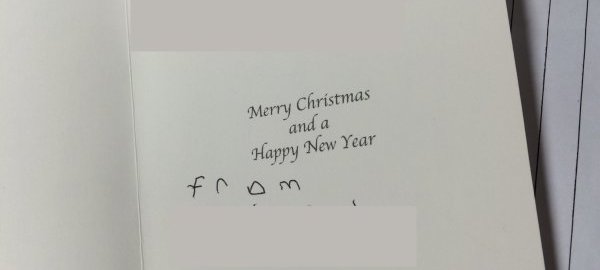
 My reasoning for our Sensory Seeker writing his Christmas cards now are for several reasons. The first is that the Christmas tree is already up at school, he has seen Father Christmas and is starting to rehearse for the Christmas production. This means it is the beginning of him requiring a bit of extra special care and attention to the spiralling confusion that is Christmas. Our Sensory Seeker is doing well so far – with just the one question on his lips, “Is it Christmas tomorrow?” I shall be glad when advent comes so he can visually see how many days there are left. I know as Christmas gets closer he will just get more disorientated with it all and tired. As I have already mentioned he is struggling with his writing and the school are
My reasoning for our Sensory Seeker writing his Christmas cards now are for several reasons. The first is that the Christmas tree is already up at school, he has seen Father Christmas and is starting to rehearse for the Christmas production. This means it is the beginning of him requiring a bit of extra special care and attention to the spiralling confusion that is Christmas. Our Sensory Seeker is doing well so far – with just the one question on his lips, “Is it Christmas tomorrow?” I shall be glad when advent comes so he can visually see how many days there are left. I know as Christmas gets closer he will just get more disorientated with it all and tired. As I have already mentioned he is struggling with his writing and the school are  Writing Christmas cards has given us a bit of quality time together, as I help sound out the words, plus guide his spacing and positioning of the words. I love to see how our Sensory Seeker has developed so much since last Christmas, his writing and his attention span. He is trying his best to do joined up writing too. He actually finished off writing his cards whilst he waited for his brother in his swimming lesson. I am so so proud that he started to remember how to write from and his name. How I tackled it was for him to write “To” and “From …..” in all of his Christmas cards, and then in another setting he added in all the names and wrote on the envelopes.
Writing Christmas cards has given us a bit of quality time together, as I help sound out the words, plus guide his spacing and positioning of the words. I love to see how our Sensory Seeker has developed so much since last Christmas, his writing and his attention span. He is trying his best to do joined up writing too. He actually finished off writing his cards whilst he waited for his brother in his swimming lesson. I am so so proud that he started to remember how to write from and his name. How I tackled it was for him to write “To” and “From …..” in all of his Christmas cards, and then in another setting he added in all the names and wrote on the envelopes.




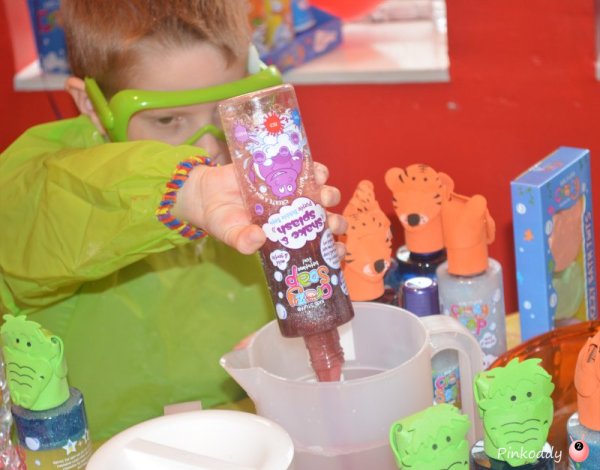

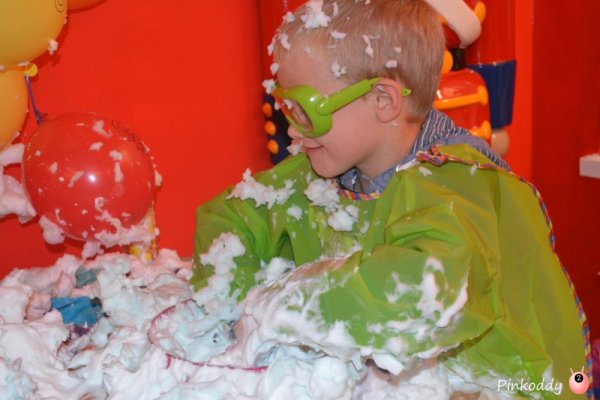





 Touch is the area that sent off the biggest alarm bells for us that our son had Sensory Processing Disorder. I say us it was the Pediatrician who first noticed it, as we struggled to peel him from stroking her shiny tights. We had completely missed the fact that he loved to cover himself in paint, and stroke people’s faces – we just thought that it was his age.
Touch is the area that sent off the biggest alarm bells for us that our son had Sensory Processing Disorder. I say us it was the Pediatrician who first noticed it, as we struggled to peel him from stroking her shiny tights. We had completely missed the fact that he loved to cover himself in paint, and stroke people’s faces – we just thought that it was his age. They use finger-tips instead of their whole hand. Give opportunities to play but without their hands e.g. touch play-dough/ paint with a brush/ spoon etc. before fingers. Slowly build them up – ie just started with finger-tips, then fingers, and reward them for trying it. Even let them play with their food.
They use finger-tips instead of their whole hand. Give opportunities to play but without their hands e.g. touch play-dough/ paint with a brush/ spoon etc. before fingers. Slowly build them up – ie just started with finger-tips, then fingers, and reward them for trying it. Even let them play with their food. They touch people & objects to the point of irritating them (our Sensory Seeker is forever holding people’s faces in his hands).
They touch people & objects to the point of irritating them (our Sensory Seeker is forever holding people’s faces in his hands). How to Help
How to Help
